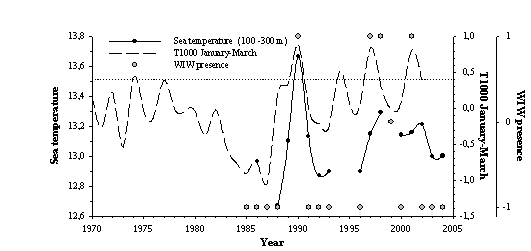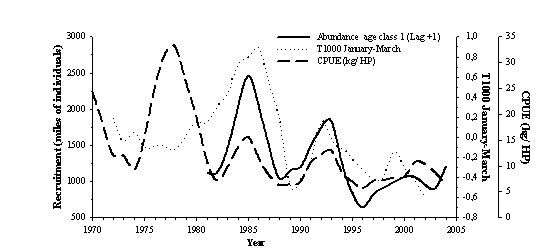XXI Trobades científiques d e la Mediterrània
El paper dels Oceans en el Canvi Climàtic
Impact of the oceanographic structure and dynamics
on the population dynamics of demersal fishery resources:
hypothesis for hake of Balearic Islands
Pere Oliver 1 , Sebastià Monserrat 2 , Enric Massutí 1 , Joan Moranta 2 , José Luis López-Jurado 1 , José Manuel Hidalgo 2 , Beatriz Guijarro 1 , Marta Marcos 2 y Romualdo Romero 3
2 CSIC/UIB- Institut Mediterrani d'Estudis Avançats, Miquel Marquès 21, 07190 Esporles
3 UIB- Departament de Física, Campus Universitari, 07122 Palma
The IDEA project analyses the population dynamics of the demersal fishery resources in the Balearic Islands from an ecosystemic perspective, i.e. taking into consideration their natural fluctuations and the forcing factors (www.ba.ieo.es/idea). One of the project objectives has focused on the study of how the inter-annual variability of abiotic factors (oceanographic structure and dynamics) could impact on the demersal ecosystems, and to be more concrete, on the population dynamics of two species exploited by bottom trawlers: hake ( Merluccius merluccius ) and red shrimp ( Aristeus antennatus ).
Previous oceanographic surveys carried out around the Balearic Islands suggest two different scenarios for the regional ocean circulation (1): (i) during cold winters, a water cooler than in milder winters is formed at intermediate layers (150-500 m) in the Gulf of Lions. This Winter Intermediate Water (WIW) usually move southward reaching de Balearic channels, deflecting the warmer Levantine Intermediate Water (LIW) coming from the eastern Mediterranean, and even stalling the Ibiza channel; (ii) during mild winters, less WIW is formed and then LIW flows through the channels appearing at their characteristic depths. At the same time, in the last decades, some inter-annual variability has also been observed in the trends of catches and population dynamics parameters of demersal species (2).
The oceanographic surveys carried out between 1986 and 2004 around the Balearic Islands have provided two data series that can characterize the presence or not of WIW in the Ibiza channel: (i) a qualitative one, indicating the presence or not, based on the analyses of TS diagrams; (ii) and another quantitative, based on mean water temperature between 100 and 300 meters depth in the channels. Both series are well correlated for the period 1985-2004 (Figure 1). Nevertheless, both data series are short and gapped. In order to obtain a longer and continuous index of presence of WIW, some atmospheric variables from the meteorological data base ERA-40 for the period 1970-2002 have been tested: (i) surface temperature (at 1000 hPa, the closest level to the surface) in 5 points (N, S, E, O and centre of the Western Mediterranean); (ii) the magnitude of components W-E and N-S of fluxes at low levels on the Western Mediterranean, based on the geo-potential height at 925 hPa. The series of air temperature anomalies at 1000 hPa in the Gulf of Lions during winter (January-March) has been shown to be the best indicator of presence/absence of WIW in the Balearic Islands channels in late spring. Values over 0.4 of the temperature anomaly would indicate absence of WIW in the Ibiza channel (Figure 1). The high correlation obtained allows using this index as an indicator of presence of WIW backwards in time and in those years for which the oceanographic data are missing.
Simultaneously, information referred to the fishing activity on hake and red shrimp around Mallorca is gathered since the 80': i.e. catches and landings, catches demography and biological and fishery parameters. These data have allowed estimating, from Virtual Population Analysis (VPA), the population dynamics of these two species, and in consequence the abundance of the species at sea (number of individuals and biomass at sea by year class and year) . Regarding hake, once the time series have been smoothed by means of a three-year running mean average, the abundance of the first year class indexes show a good correlation with the index of presence of WIW (Figure 2). The three maximum values of abundance (1984, 1992 and 1999) fit well with the maximum values of negative anomalies of temperature in the Gulf of Lions (i.e. clear presence of WIW in the Ibiza channel). However, abundance estimates are only possible from 1980 onwards. For previous years only catch per unit effort indexes (CPUE) are available to estimate the resource abundance. The maximum values of CPUE fit also well with the anomaly after the 80', with the only exception of the 1999 peak, probably due to the fact that in these years the exploitation targeted on older individuals more than on the first year class. High values of CPUE registered in the 70' do not fit well with this scenario. In this period, in which there is no information on the demography of catches, the fishing exploitation of this population had not reach the level of Maximum Sustainable Yield (MSY) and hence the capacity of resistance of the species to adverse environmental situations was supposed to be better than the one of the years after, when the population is showing a situation of overexploitation. As a conclusion this high correlation between hake dynamics and clear presence of WIW in the Balearic Islands since 1980, suggests an environmental favourable scenario for hake abundance in the area.
 |
|---|
Figure 1.- Standardized air temperature anomaly in the Gulf of Lions (T1000 January-March), water temperature in the Ibiza Channel between 100 and 300 meters depth and presence of WIW in the Ibiza Channel. (-1: well marked presence; 0: some presence; 1: absence of WIW). |
 |
Figure 2.- Negative air temperature anomaly in the Gulf of Lions (T1000 January-March) and series of abundance of the first year class and CPUEs of hake. Both variables are smoothed, by means of a three years running mean average. Note that the temperature anomaly is presented inverse by respect to the Figure 1. |
The studies on the influence of different waters masses on species of slope shrimps are scarce. However, in the Mediterranean it has been suggested a possible association of these species with water masses of low temperature and high salinity (3). For this reason, the project IDEA is working looking for an index to characterise the level of presence of this type of water masses in the area, in order to facilitate the analysis of their possible impact on the population dynamics of the red shrimp.
(1) Pinot J.M., J.L. López-Jurado & M. Riera.- 2002. The CANALES experiment (1996-1998). Interannual, seasonal, and mesoscale variability of the circulation in the Balearic Channels. Progress in Oceanography , 55 : 335-370.
(1) Mertens C. & F. Schott.- 1998. Interannual Variability of Deep-Water Formation in the Northwestern Mediterranean . Journal of Physical Oceanography , 28: 1410-1424.
(2) Oliver P.- 1993. Analysis of fluctuations observed in trawl landings of Balearic Islands . Scientia Marina , 57 : 219-227.
(3) Ghidalia W., & F. Bourgois.- 1961. Influence de la témperature et de l'éclairement sur la distribution des crevettes des moyennes et grandes profondeurs. Stud. Rev. Gen. Fish. Counc. Médit. , 16: 1-53.